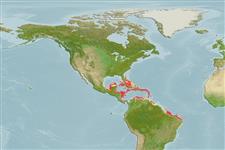>
Blenniiformes (Blennies) >
Chaenopsidae (Pike-, tube- and flagblennies)
Etymology: Lucayablennius: Composed from Lucaya = the old name for the Bahamas Islands + Greek, blennios = mucus (Ref. 45335).
Environment: milieu / climate zone / depth range / distribution range
Ecología
marino asociado a arrecife; rango de profundidad 13 - 106 m (Ref. 9710). Tropical
Western Central Atlantic: Bahamas and Caribbean, including the Antilles.
Tamaño / Peso / Age
Maturity: Lm ? range ? - ? cm
Max length : 5.0 cm SL macho / no sexado; (Ref. 51458)
Short description
Morfología | Morfometría
Espinas dorsales (total): 18 - 20; Radios blandos dorsales (total): 19-20; Espinas anales 2; Radios blandos anales: 22 - 23. With emarginate caudal fin. Reddish tan, with 3 large dark spots along rear of dorsal fin base, and 2 similar spots along rear of anal fin base (Ref. 26938). Black stripe from tip of lower jaw through eye to end of operculum; a median dorsal light yellow line on head (Ref. 13442).
Inhabits coral reefs (Ref. 5521). Drifts with bended tail to prey on small fish. Retreats into holes or empty worm tubes. Ignores divers (Ref. 9710). Often seen with schools of masked gobies (Ref. 26938).
Life cycle and mating behavior
Madurez | Reproducción | Puesta | Huevos | Fecundidad | Larva
Böhlke, J.E. and C.C.G. Chaplin, 1993. Fishes of the Bahamas and adjacent tropical waters. 2nd edition. University of Texas Press, Austin. (Ref. 5521)
IUCN Red List Status (Ref. 130435)
Threat to humans
Harmless
Human uses
Más información
Nombres comunesSinónimosMetabolismoDespredadoresEcotoxicologíaReproducciónMadurezPuestaAgregación para la puestaFecundidadHuevosEgg development
Age/SizeCrecimientoLength-weightLength-lengthLength-frequenciesMorfometríaMorfologíaLarvaDinámica larvariaReclutamientoAbundanciaBRUVS
ReferenciasAcuiculturaPerfil de acuiculturaRazasGenéticaElectrophoresesheritabilidadEnfermedadesProcesamientoNutrientsMass conversion
ColaboradoresImágenesStamps, Coins Misc.SonidosCiguateraVelocidadTipo de nataciónSuperficie branquialOtolitosCerebrosVisión
Herramientas
Special reports
Download XML
Fuentes de Internet
Estimates based on models
Preferred temperature (Ref.
123201): 23.5 - 27.6, mean 26.5 °C (based on 71 cells).
Phylogenetic diversity index (Ref.
82804): PD
50 = 1.0000 [Uniqueness, from 0.5 = low to 2.0 = high].
Bayesian length-weight: a=0.00457 (0.00183 - 0.01143), b=3.08 (2.86 - 3.30), in cm total length, based on LWR estimates for this (Sub)family-body shape (Ref.
93245).
Nivel trófico (Ref.
69278): 3.5 ±0.5 se; based on size and trophs of closest relatives
Fishing Vulnerability (Ref.
59153): Low vulnerability (10 of 100).
Nutrients (Ref.
124155): Calcium = 173 [78, 327] mg/100g; Iron = 0.905 [0.511, 1.640] mg/100g; Protein = 17.8 [16.6, 19.0] %; Omega3 = 0.125 [0.063, 0.243] g/100g; Selenium = 25.9 [10.7, 60.8] μg/100g; VitaminA = 366 [112, 1,263] μg/100g; Zinc = 2.2 [1.4, 3.3] mg/100g (wet weight);
